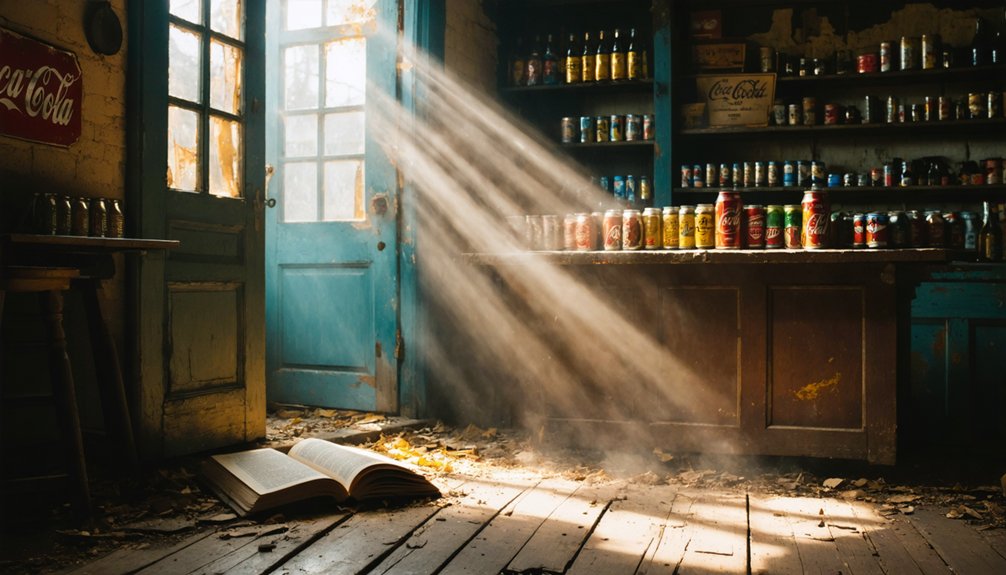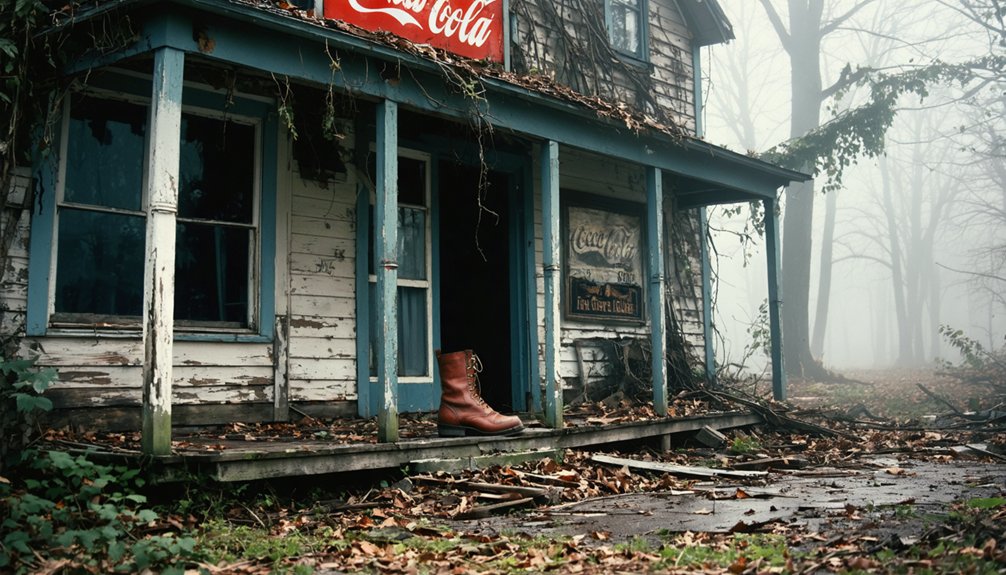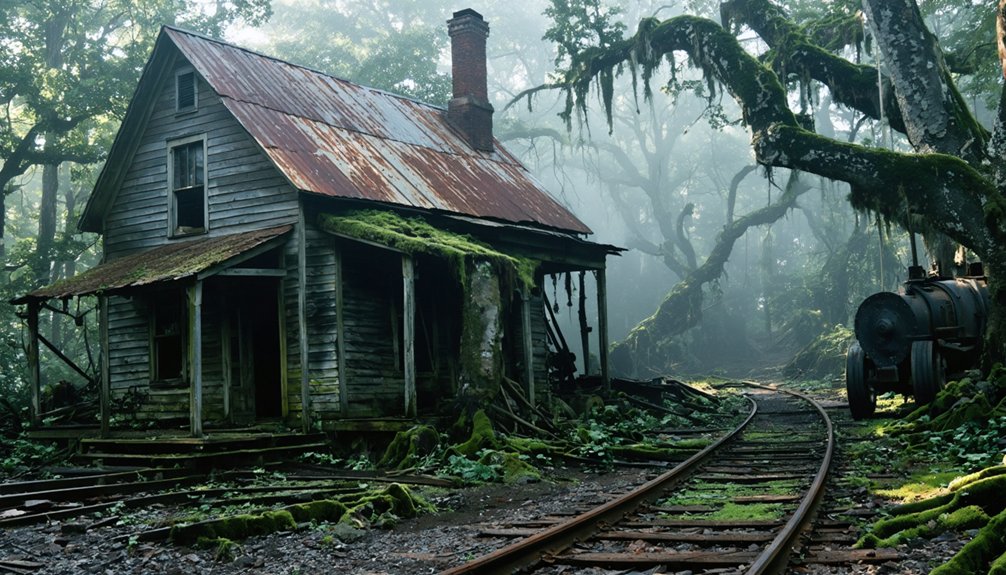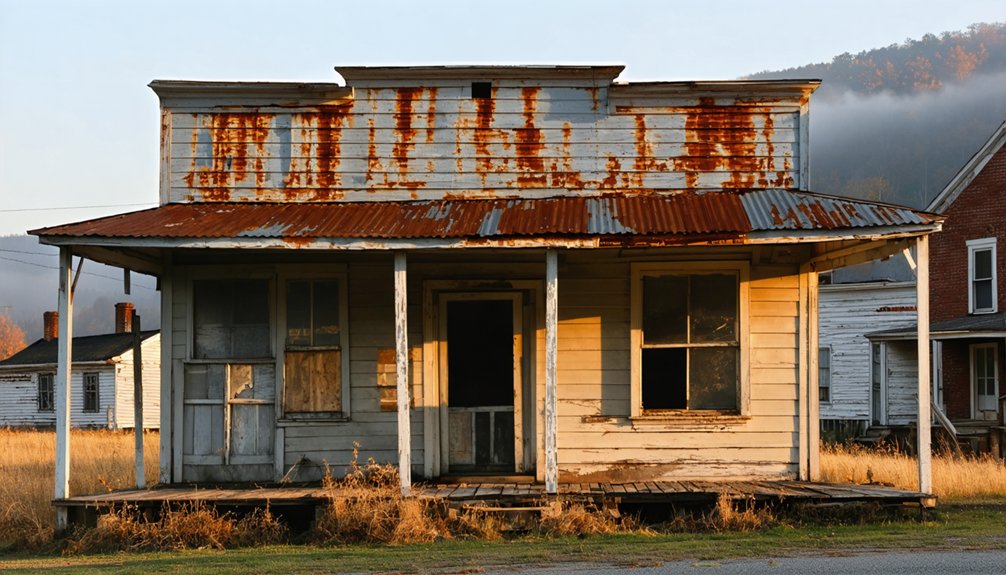You’ll find Jonican, a Kentucky ghost town, 7.2 miles east-southeast of Pikeville at coordinates 37°26′58″N 82°23′32″W. This former settlement, established in the 1820s by Virginia pioneers, grew around timber and coal industries along Jonican Branch. While the town declined after mid-20th century mine closures, you can still access its remnants via Jonican Road. The site’s scattered foundations and natural reclamation tell a deeper story of Appalachian pioneer life.
Key Takeaways
- Jonican is an abandoned settlement located 7.2 miles east-southeast of Pikeville, Kentucky at coordinates 37°26′58″N 82°23′32″W.
- Established in the 1820s by Virginia pioneers, Jonican developed as a rural community supported by timber harvesting and coal mining.
- The town was built along Jonican Branch waterway and relied on subsistence farming, local trade networks, and resource extraction.
- Economic decline began with coal mine closures in mid-20th century, causing younger residents to leave and businesses to shut down.
- Today, Jonican remains accessible via Jonican Road, with scattered foundations and debris marking its former location in Pike County.
Mapping the Lost Settlement of Jonican
Located 7.2 miles east-southeast of Pikeville, Kentucky, you’ll find the abandoned settlement of Jonican at coordinates 37°26′58″N 82°23′32″W.
Deep in Kentucky’s Pike County, the ghost town of Jonican stands frozen in time, 7.2 miles from Pikeville’s bustling streets.
For ghost town exploration enthusiasts, this forgotten community remains visible on modern county highway maps, making it an accessible destination via Jonican Road. You’ll discover the settlement nestled along Jonican Branch, a waterway that once sustained the local population. The area’s position in the Appalachian Mountains region has shaped its historical development and ultimate fate. Visitors can access detailed dictionary entries about the area’s landmarks and geographical features.
Historical mapping records show that the area, also known as Jonkan, represents one of Kentucky’s documented ghost towns.
While venturing through Pike County’s back roads, you can trace the remnants of this lost community using both contemporary GPS coordinates and traditional map references. The site’s clear marking on current maps makes it a prime location for those seeking to explore Kentucky’s abandoned places.
Origins in Pike County’s History
When you explore Pike County’s early settlement patterns of the 1820s, you’ll find that pioneering families established homesteads along creek valleys, often traveling from Virginia through Pound Gap with minimal provisions and crude tools.
The harsh mountain terrain shaped how these communities developed, with settlers like “Dad” Owens and James Honaker choosing locations near water sources and natural shelters along the Big Sandy River. These early settlers needed local governance structures to manage their growing communities, which led to Pike County’s establishment in 1821.
You can trace the emergence of mountain communities through the gradual development of dirt roads, general stores, and donated land plots that formed the backbone of Pike County’s rural infrastructure. Transportation relied heavily on horses and sleds for moving goods across the difficult mountain paths.
Early Settlement Patterns
As settlers pushed deeper into Kentucky’s eastern frontier in the late 18th century, Pike County’s rugged terrain shaped distinctive settlement patterns that would influence communities like Jonican.
You’ll find that early pioneers followed ancient buffalo traces and river routes, establishing homesteads near water sources essential for survival and transportation.
Settlement dynamics reflected the region’s challenging landscape, with communities forming in isolated pockets along the Upper Levisa and Tug Fork areas.
You’d see how natural barriers and limited access fostered strong community cohesion, as families relied on subsistence farming and local trade.
Early settlers used pack horse trains to move goods, following ridgelines between the Kentucky River and Levisa Fork.
Like many small towns that emerged during Kentucky’s timber and coal boom, Jonican’s growth was tied to resource extraction.
The mountainous terrain that tested early surveyors would continue defining these communities’ development for generations. Major Andrew Lewis explored these challenging landscapes around 1756, contributing to early mapping efforts.
Mountain Community Development
Since the late 1960s, Pike County’s mountain communities have undergone dramatic transformations through ambitious federal and state development initiatives.
You’ll find evidence of this change in Pikeville, which became the region’s first Model City in 1968, sparking unprecedented community engagement through the massive Cut-through Project. This $77.6 million endeavor moved 18 million cubic yards of earth, created 400 acres of developable land, and revolutionized local infrastructure. This area represents one of many Pike Counties across America named for explorer Zebulon Pike.
The path toward sustainable development hasn’t been simple. While coal mining replaced traditional farming and timber industries in the early 20th century, local organizations like the Mountain Association have worked since 1976 to diversify the economy. Many families initially depended on hillside farming for survival before the rise of coal mining.
They’ve partnered with institutions like the University of Pikeville to support education, small businesses, and community-driven initiatives that shape the region’s future.
Life in Early Rural Appalachia
You’d find early Appalachian mountain families living in scattered farmsteads, growing corn and raising hogs for their basic needs in Pike County’s challenging terrain.
The Ulster Scots settlers were among the first Europeans to establish homesteads in this rugged region during the 1700s.
Your family’s survival would depend heavily on subsistence agriculture and bartering with nearby households, as the isolated geography made external trade difficult.
You’d rely on extended family networks and neighbors for mutual support, sharing labor and resources within your small community to overcome the harsh demands of mountain life.
Most settlements began in protected coves with access to good water, farmable land, and plentiful timber for building.
Daily Mountain Family Life
While life in early rural Appalachia demanded constant work and self-sufficiency, the mountain families of Jonican maintained strong social bonds through shared labor and traditions.
You’d find households where everyone pitched in – women managing domestic duties like cooking and sewing, men hunting and farming, and children helping with daily routines from an early age.
Family traditions centered around essential skills passed down through generations, from preserving food to crafting herbal remedies.
Your days would start at sunrise, filled with tasks like tending livestock or gathering wild edibles.
In the evenings, you’d join neighbors for storytelling or music, strengthening community ties that helped you weather isolation and harsh conditions.
These shared experiences created resilient family networks that sustained mountain life.
Farming For Basic Needs
The early settlers of Jonican learned to blend indigenous agricultural wisdom with European farming traditions, creating a unique approach to mountain cultivation.
You’d have found yourself practicing subsistence farming on steep hillsides, following natural contours for terracing while rotating between infield and outfield plots to maintain soil fertility.
Your crop diversity would’ve included the indigenous triad of corn, beans, and squash, supplemented by European introductions like apples and sweet potatoes.
You’d have raised hogs and fowl, with some families keeping cattle despite the challenges of mountain terrain.
When lower plots became depleted, you’d move higher up the mountainside for fresh soil.
Like other mountain communities, you’d have relied on creek farming in the narrow bottomlands, while gathering wild plants like ginseng to supplement your harvests.
The Geography and Natural Setting
Nestled along Jonican Branch approximately 7.2 miles east-southeast of Pikeville, Kentucky, Jonican’s natural setting exemplifies classic Appalachian terrain with its rugged hills and narrow valleys.
Hidden within Kentucky’s ancient hills, Jonican captures the essence of Appalachia’s untamed landscape through its steep ridges and winding hollows.
You’ll find yourself surrounded by rich natural resources, including coal seams, sandstone, and shale deposits that once drove the area’s development. The region’s ecological diversity shines through its mixed hardwood forests of oak, hickory, and maple trees that blanket the surrounding hills.
The humid subtropical climate supports lush vegetation throughout all four seasons, while Jonican Branch, the local stream, shapes the valley’s ecosystem.
Today, nature has largely reclaimed the ghost town‘s footprint, though you can still access the area via Jonican Road. The surrounding wilderness preserves the raw, untamed beauty that’s characteristic of Kentucky’s Appalachian foothills.
Community Structure and Daily Living

Life in Jonican centered around modest wooden homes that lined the unpaved main road and creek, reflecting typical early 20th-century Appalachian architecture.
You’d find families relying heavily on each other, with men working long hours in mining or timber while women managed households and gardens. The town’s heartbeat was felt in its community gatherings at the local church and school, where neighbors came together for both spiritual comfort and social connection.
You’d see children walking to the small schoolhouse, while adults would meet at the general store to exchange news and goods.
Extended families lived close by, creating strong support networks essential for mountain living. Daily routines revolved around shared labor, with neighbors helping neighbors through farming, construction, and other crucial tasks that sustained the isolated community.
Economic Activities and Local Trade
Working alongside their neighbors in shared community tasks, Jonican residents built a diverse economic foundation that extended beyond simple household sustainability.
Through collective effort and neighborly cooperation, Jonican’s people created an economic system that flourished beyond basic survival needs.
They developed robust trade networks with neighboring towns, exchanging local agricultural products and handcrafted goods. You’d have found a mix of small-scale farming operations and specialized trades that supported the region’s coal mining industry.
The community’s economic strength came from its ability to adapt, using local bartering systems when cash was scarce. Residents traded surplus crops for essential services, while local merchants maintained connections with larger markets in Pike County.
Small manufacturing ventures, including textile production and woodworking, provided additional income streams. This economic diversity helped sustain the town until broader regional changes began affecting local industries and traditional trade patterns.
The Path to Abandonment

When coal mining began to falter across eastern Kentucky in the mid-20th century, Jonican’s fate became increasingly precarious. The economic shifts hit this remote community particularly hard, as mine closures eliminated jobs that had sustained local families for generations.
You’d have witnessed a chain reaction of decline: younger residents moved away for work, local businesses shuttered, and community institutions gradually disappeared.
The town’s isolation along Jonican Branch only accelerated its community decline. Without major road access or alternative industries to cushion the blow, Jonican couldn’t attract new investments.
Environmental damage from mining made the land less viable for farming, while aging infrastructure went unrepaired. As schools and stores closed their doors, the remaining population – mostly elderly residents – found themselves in an increasingly unsustainable situation.
Present-Day Remnants and Location
Today, Jonican lies hidden among the rugged Appalachian terrain of Pike County, Kentucky, roughly 7.2 miles east-southeast of Pikeville.
Nestled in Pike County’s Appalachian wilderness, Jonican remains a hidden secret just miles from Pikeville’s busy streets.
You’ll find this ghost town along Jonican Branch and its namesake road, though nature has largely reclaimed what’s left of the settlement. The site’s location accessibility is limited to local roads, reflecting its remote character.
If you’re planning remnants exploration, you won’t find any preserved buildings standing. Time and abandonment have reduced most structures to scattered foundations and debris, now covered by thick forest growth.
The surrounding wilderness showcases typical Appalachian flora and fauna, while nearby mountain landscapes remind visitors of the region’s untamed spirit. Without historical markers or official trails, you’re free to discover this forgotten piece of Kentucky history on your own terms.
Legacy in Kentucky’s Ghost Town Heritage

Given the lack of historical documentation about Jonican, this purported ghost town represents one of many undocumented settlements that have faded from Kentucky’s collective memory.
You won’t find Jonican in official records, historical society archives, or mainstream ghost town registries – highlighting how some of Kentucky’s lost communities exist only in regional folklore and local stories passed down through generations.
While Kentucky’s documented ghost towns tell rich tales of boom-and-bust cycles, railroad abandonments, and shifting economies, Jonican’s absence from historical records makes it impossible to verify its role in the state’s heritage.
It’s a reminder that beyond the well-known ghost town myths and documented abandoned settlements, there’s a layer of Kentucky’s history that remains elusive, preserved only in undocumented oral traditions, if at all.
Frequently Asked Questions
Were There Any Notable Crimes or Incidents Reported in Jonican’s History?
You won’t find unsolved mysteries or local legends about crimes here – historical records show no notable criminal incidents in the town’s history before it became abandoned due to coal mine closures.
Did Native American Settlements Exist in the Jonican Area Before Colonization?
Yes, you’ll find extensive evidence of Native American settlement patterns in the area, with archaeological records showing Shawnee villages and earlier indigenous communities dating back thousands of years along regional waterways.
What Was the Primary Source of Drinking Water for Residents?
Clear as crystal, you’d have found well water from hand-dug wells and spring sources being your primary drinking options, with the reliable Jonican Branch stream serving as a backup water supply.
Were There Any Churches or Religious Gatherings in Jonican?
You won’t find documented church history or religious gatherings in Jonican’s records. While nearby coal towns often had churches, there’s no evidence of formal religious establishments or meeting places in this community.
Did Any Famous People or Historical Figures Ever Visit Jonican?
You won’t find any records of famous visitors or historical figures stopping in Jonican. Unlike other Kentucky ghost towns that attracted notable personalities, this small coal mining community didn’t achieve that kind of historical significance.
References
- https://kids.kiddle.co/List_of_ghost_towns_in_Kentucky
- https://en.wikipedia.org/wiki/Jonkan
- https://www.onlyinyourstate.com/experiences/kentucky/ghost-town-ky
- https://womiowensboro.com/have-you-ever-visited-these-ghost-towns-in-kentucky-video/
- https://www.youtube.com/watch?v=D9gOmfCuKLs
- https://lostandabandonedadventures.weebly.com/ghost-town-of-jonkan-kentucky.html
- https://wbkr.com/visit-these-20-creepy-kentucky-ghost-towns-for-a-halloween-road-trip/
- https://en.wikipedia.org/wiki/List_of_ghost_towns_in_Kentucky
- https://www.wikiwand.com/en/map/Jonkan
- https://kids.kiddle.co/Jonkan



